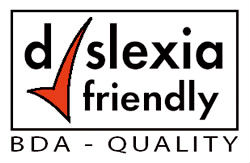BDA Dyslexia Friendly Quality Mark

If you are having difficulty viewing this website please visit the accessibility page (button located at the top of your screen) to change the text size and background colour.
We are a BDA recognised Dyslexia Friendly School
At St. Joseph's we recognise that all learners are different. For this we undertake learning styles audits to identify how each child prefers to learn. Classrooms have a visual reminder of pupils’ preferred learning styles and they have opportunities to develop their learning through auditory, visual and kinaesthetic methods. We help children develop all of their talents and strengths by identifying the different ways in which they are smart. Our pupils also develop their strengths and interests through the wide range of after-school clubs and additional curricular activities on offer throughout the school year.
In St Joseph's we have in place dyslexia friendly strategies that support all children in each classroom.
- We believe that each child should feel good about themselves and their learning.
- Each child is expected to make progress and achieve success.
- We celebrate and recognise our pupils’ successes.
- We incorporate group work, thinking skills and independent life skills for all our pupils.
- We have smart-boards in every classroom.
- We use I.C.T as a tool to support learning.
- Most members of staff are trained in identifying and supporting pupils with dyslexia.
- Pupils are monitored closely to identify areas for support.
- Dyslexia friendly strategies are employed in all classes.
- We use multi-sensory teaching methods, particularly in literacy and reading.
- Multi-sensory spelling strategies are taught.
- We encourage the use of coloured backgrounds, reading rulers and paper to reduce glare and visual stress.
- A dyslexia friendly marking policy is in place in all classrooms.
What is Dyslexia?
Dyslexia comes from Greek and means ‘difficulty with words’. It is more than just difficulty with reading; dyslexic individuals may also have problems with spelling, writing, maths, foreign languages and problems with organisation in general. Another term for Dyslexia is ‘Specific Learning Difficulties’.
Fortunately only a very small number of young people are severely affected by dyslexia. 1 in 10 children may have mild dyslexic tendencies. This means that with good teaching at school and continued encouragement from home, a child can become quite a confident reader but may continue to have some problems with spelling or other areas. Dyslexia does not mean a child is stupid; it does mean that s/he learns differently. S/he processes and receives information in a different way. In St. Joseph’s teachers use multi-sensory methods and find that these are most effective as they make use of all the possible ways to learn.
What does this mean for my child at St. Joseph's?
Teachers and classroom assistants at St. Joseph’s are trained to spot the indicators of dyslexia. We have thorough assessment procedures in place to identify if a child is having difficulty in any area. Early Identification of difficulties means that support can be given, either through careful teaching in class; learning programmes developed by the teacher; support given through additional resources or homework programmes. If difficulties continue a child will be referred to the SENCO (Special Educational Needs Co-ordinator). Additional diagnostic testing will be undertaken to identify the area of focus. Children may be referred for reading recovery, additional reading support or offered a place in a booster group.
In cases of severe dyslexia, where a child’s progress is not being met, a referral may be made to the Educational Psychologist and external agencies may be asked for support. However once identified, good teaching and support from home can reduce the effects of dyslexia. There is no reason why a child with dyslexia should not succeed once the difficulty has been identified and followed up with appropriate teaching across the curriculum. Please contact your child’s teacher if you have any other questions or concerns.
St Joseph's Primary School, 54 Greystone Road, Antrim BT41 1JZ | Phone: 028 9446 2076
WEBSITE BY: SCHOOLWEBDESIGN.NET | Login
 Menu
Menu
